Public Relations Training For Startups, Steemers & Steemit: PART 3
Personal Message From Michael
Greetings!
My name is Michael, and I have personally helped train well over 20,000+ small businesses and entrepreneurs over the last 7 years in the realm of online marketing, paid and free traffic strategies, public relations and branding, news media releases, authority marketing, and of course SEO (Search Engine Optimization) & SEM( Search Engine Marketing).
This is a continuation of the Public Relations For Startups and Steemit: Part 1 found here.
You may also visit PART 2 HERE.
Please follow along part 3 below, and don't forget to comment, share, upvote and follow me!
Keep Working Hard!
Michael

Follow Me On Steemit - The Social Media Platform That Pays
Please Connect To Me On Linkedin!
Crafting Your Pitch Public Relations Pitch
The Pitch Success Formula I have created can be broken down into this easy to remember word.
Simple
Can it be pitched in a subject line?
Unexpected
You’ve got my attention, now can you keep it?
Concrete
Can you express this in terms I can understand?
Credible
Why are YOU telling this story?
Emotional
Why does this matter to my audience?
Stories
What’s the narrative? How’s it flow?
Support
Are you supporting their agenda?
Let’s look at some successful pitches and break them down on how/why they were effective!
- Bryan is a customer, and let’s them know - showing he is clearly familiar with the product.
- KISSmetrics is a respected name in the industry, so the name drop helps establish his expertise and knowledge of the industry since they trust him enough to publish his work.
- He proves #2 by linking to an example of his previous work. This is great social proof for him, and the target can quickly verify his claims, and even see how much traction the content Bryan creates for KISSmetrics yields.
- Value Proposition To Target: Here is the big kicker on the email - Bryan went ahead and made a content post before they even said yes. He took a chance and spent his precious time making it, but it is sure to get their attention.
- The email was closed with a question. This makes it quite easy for the recipient to answer, and increases Bryan’s chance at receiving a response by making the end a call to action.
Key Takeaway: Giving away massive value right at the pitch might take time and energy upfront, but will pay off by getting noticed. Every little bit counts when it comes to standing out in an inbox.
- First off, they clearly identify the sender, their current role in the company, and the product/service they are promoting.
- This is effective in two ways. First, it shows in a fun way that the sender did do research on who to contact. Second, by just asking if they are the right person or not, you create a slight call to action. Don’t be afraid to ask if you aren’t sure who the right person is.
- They are very upfront about their intention for the email by attempting to schedule a call. What is nice about this pitch is that they offer the fact that the call is only going to be around 15 minutes, so it helps with scheduling as well as gives an idea of the whether they want to commit time or not to speaking to the sender. It also lists exact dates and times.
I like to include a few dates and times in the email, or use my artificial intelligence assistant Amy Ingram at http://x.ai to schedule it for me.
Key Takeaway: Identify yourself, make sure you are speaking to the correct person in their organization, and be clear about how much time of theirs you are requesting from them. Being upfront, and very clear about your intentions goes a long way.
- The first part of the pitch is fantastic, because you either love it, or hate it - but you can’t ignore it. Sam mentions Rick’s past in this part as well, which is likely little known information. This shows Sam actually knows what he is talking about, and to whom.
- Super quick and easy introduction to what Sam is sending the email about, summed up in a single sentence. I also want to note the portion where Sam offers Rick to spread his gospel. That was quite smart, as it shows that Sam understand entrepreneurs at Rick’s level care less about money and more about evangelising their thoughts and ideas.
- He doesn’t waste Rick’s time and write a huge email about the event. Instead, he links to a page that has conference information.
Bonus: Sam sent really cool GIFs to the recipients of his pitch emails. This is a sure-fire way to personalize a message in a very memorable way

Key Takeaway: Don't be afraid to have fun with your pitches, and use the language and image of your brand. It makes you unique, shows what your company culture is like.
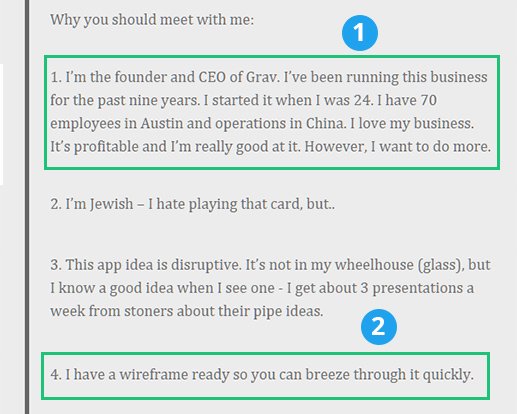
- If you have ever dealt with extremely busy people, you know that you must be upfront. Dave sent this to someone he knows is successful, and he knows successful people like to speak to other successful people. First thing, he went right into who he is and what he has done. It may sound counter intuitive to be boastful or arrogant, but in this case it shows that Dave knows his stuff quite well.
- The fact that Dave created a wireframe means he is 95% ahead of every other person that wants to pitch an app or has an idea for an app.
Bonus: Making the email about the recipient is a great practice to adopt in your emails. This pitch showed clearly what the recipient could get from a meeting with Dave. Dave also used a list format when presenting his pitch. People inherently like lists, and it makes the subject matter easy to read, and easy to segment.
Key Takeaway: If you are emailing a busy person (most of them will be), then don’t be shy in presenting yourself and what you can do for the recipient. If you are writing long email pitches, creating a list type format makes it easier to get away with.
- There was a very recent interaction between John and Noah - John reminded Noah about the tweet so he could remind Noah he wasn’t a stranger.
- I mentioned this previously, but letting a busy target know you are not going to steal hours out of their day with them goes a long way to reassuring them they want to respond with booking a time. This is made clear as John states he is looking for 5-7 minutes of time.
- A name drop about a very respected and trusted publication that has used his content, as well as a mutual friend helps establish trust.
- Yet another namedrop, same as #3 in intention and result.
- If you know your target has something fun or quirky about them, use it to your advantage. Noah has a legendary love of tacos, Dave took advantage of the fact and mentioned the common ground.
Key Takeaway: Any common connection you have is worth mentioning. If you have previous works in trusted/industry publications, mention them. And learn about your targets quirks if you can, a little goes a long way (think TV shows, music interests, anything shared on social media...)!
The Importance of Subject Lines
85% of journalists and influencers open their email based on the subject line alone. Subject lines are the first (and maybe your last) chance to make an impression on your target. When it comes to content, it is as important if not more important than the actual pitch.
Why? If the subject line doesn’t entice them to open your email, they will never see the amazing pitch you crafted just for them.
If you have an hour to write a pitch, you want to spend 45 minutes on the perfect subject line. It is THAT important to nail it the first time.
The Formula For Highly Effective Subject Lines
- Write the subject line first.
One of the top mistakes people make on email is forgetting to write a subject line. An email with a blank subject line will likely go unread or get lost in a cluttered inbox. Always write the subject line before the email so you know it’s taken care of.
- Keep it short.
A typical inbox reveals about 60 characters of an email’s subject line, while a mobile phone shows just 25 to 30 characters. Get right to the point in about six to eight words.
- Place the most important words at the beginning.
A whopping 50% of emails are read on mobile phones. Since you don’t know how much of the subject line will be viewable from a smartphone, it’s important to put the most important information at the beginning. Otherwise, compelling details could get cut off.
- Eliminate filler words.
With such precious space, don’t waste it with unnecessary words like “hello,” “nice to meet you,” and “thanks,” which can easily be included in the email’s body.
- Be clear and specific about the topic of the email.
The subject line should communicate exactly what the email is about so that the recipient can prioritize the email’s importance without having to open it. For example, writing “Do you have a sec?” is vague since the reader will have to open the email or reply to figure out what you want.
- Keep it simple and focused.
Especially if you’re sending a marketing email. It should be focused on one action, which should be communicated in the subject line. Offer one takeaway, indicate how the reader can make use of it, and specify how you will deliver it.
- Use logical keywords for search and filtering.
Most professionals have filters and folders set up to manage their email and probably won’t focus on your message when they first see it. That’s why it’s important to include keywords related to the topic of the email that will make it searchable later.
- Indicate if you need a response.
People want to know whether they really need to read this now and if they have to respond. If you need a response, make it clear in the subject line by saying “please reply” or “thoughts needed on X topic.” If not, simply start the line with “Please read,” or tack on “no response needed” or “FYI” to the end.
- Set a deadline in the subject line.
Especially if you have a lot of information to convey in the email itself, including a deadline right in the subject line exponentially increases the odds that readers will respond. For example, after the email’s topic, you could say: “Please reply by EOD Friday.”
10. If someone referred you, be sure to use their name.
If you’ve been referred by a mutual acquaintance, do not save that for the body of the email. Put it in the subject line to grab the reader’s attention right away. Moreover, you may try beginning the subject line with the full name of the person who referred you.
11. Highlight the value you have to offer.
If sending a cold email to someone you don’t know, you need a subject line that indicates value and communicates what they’re going to get. Tickle the reader’s interest by offering them something that’s helpful.
Whether you’re providing a speaking opportunity, a discount, or a service, make it clear in the subject line what’s in it for them. Always try to offer them something that get's them further to their goals, and you will find more success.
12. Personalize it with the recipient’s name or company name.
You have to know who you’re sending the email to, and they have to recognize that it’s about them or a subject interesting to them. Using their name or company name is one way to do that, and makes the recipient much more likely to open the email.
For example, you might write, “Increase MyCompany.com’s traffic by 25%,” or “Frank, see how you compare to competitors.” Try different things and the key is to be different and get their attention.
13. Don’t start a sentence that you finish in the email’s body.
If you begin a thought or question that ends in the email, then the reader is forced to open the email. It’s annoying, and since clarity and being respectful of the recipient’s time is the goal, it’s not very helpful. So don't do it.
14. Make sure you reread the subject line.
Sometimes when people are sending a similar email to multiple people, they forget to tailor it to each reader and end up with the wrong name or title in the subject line. That is the fastest way to end up in the trash (or SPAM box). The easiest way to avoid this is to reread the subject line before you hit send. Make sure you always test your email before you send it.
15. Don’t put words in ALL CAPS.
Using all caps may get someone’s attention, but in the wrong way. It’s the digital equivalent of yelling, and your job is to make the email as easy as possible for the recipient to read rather than giving them anxiety. The big takeaway here is to avoid caps and special characters like exclamation points.
There are other ways to come up with subject lines, one way is to look in your inbox and look at other peoples subject lines. Another is to use tools that will help generate subject lines for you.
Below are some subject lines that were used by companies, as well as a subject line generator and a subject line scoring tool. You can use these tools to get inspiration, or use the actual subjects that they hope you generate. As you craft your own subject lines, you will get used to writing them and get better at it as you go.
Other Subject Line Resources:
Checklist for 100 subject lines used at SXSW
Amazingly Awesome Subject & Title Generator
Sending Your Pitch
A survey was conducted by Fractl in 2014, in which they asked journalists about being pitched, and how they prefer to be pitched when contacted by an interested party.
Journalists and influencers prefer to be pitched via email. Do not cold call, do not just show up physically, do not pitch them on social media. They want it in an email.
Overwhelmingly, journalists prefer to be pitched in the morning. That means you need to send those emails in the morning (their morning not yours) if you want them to even consider the pitch. Find a way to send them at the right times manually, or use software or an autoresponder to time the email being sent.
When you pitch them, do not pitch them one story or line of thought set in stone. When asked, 69% of them said they prefer to be pitched a set of ideas rather than a predefined story.
They want to be a part of the content creation process, so make sure you allow them to do so or they won’t feel the need to reply.
39% of them liked exclusive research data as attractive to them in a pitch or potential story.
One of the biggest points I need to drive home in this section is spelling and grammar. Over 70% of those polled said they would trash the pitch regardless of content, if there were spelling and/or grammar errors.
That means you must spell check. You must check your grammar, and you must make sure everything looks legit.
Tools for Sending the Pitch
One of the best tools you can use for pitching your targets and tracking them is Gmail. Yep that's right, Google's very own email service. Even though it's a simple tool, it's very powerful when combined with a couple of other tools.
Sidekick(now called Hubspot Sales) is an amazing Google Chrome plugin that integrates with Gmail.
You can use it to do all sorts of really cool stuff, like monitor your email conversations and see if your target has opened to email, clicked on anything, forwarded the email, and many other features.
This is obviously important when it comes to tracking your pitch and the effectiveness of your reach out.
You can download the plugin for Google Chrome here: https://chrome.google.com/webstore/detail/hubspot-sales/oiiaigjnkhngdbnoookogelabohpglmd?hl=en
Boomerang is another amazing tool that integrates with Google Chrome as a plugin and plugs into Gmail. You can use boomerang to perform tasks such as remind you if an email has not been responded to, automatically send an email to somebody if they have not responded, if they have not opened an email, and many other features.
You can download the plugin for Google Chrome here:
https://chrome.google.com/webstore/detail/boomerang-for-gmail/mdanidgdpmkimeiiojknlnekblgmpdll?hl=en
Using these tools together makes Gmail a very powerful tracking tool for you. It also allows you to reach out without spending a ton of money on tools. Both of these tools may be used for free, and if you want to eventually upgrade you can.
Tracking Your pitch
As I said before, tracking is important, and you need to devise a system that works for you. By using Boomerang, you can track engagement, and by using a spreadsheet (or a CMS) you can keep track of your targets, the intel gathered on them, the pitch, and the results.
You can setup your tracking sheet as you wish, however I urge you to put in enough information to be able to stay on top of everything.
Rule of thumb is that if a stranger were to open the sheet and look at it, they would understand each situation.
If that is the case, then your spreadsheet is organized well and has enough data.
I prefer to setup multiple worksheets that are segmented into high value targets and regular value targets. I will also segment a sheet based on the target types, such as investor, influencer, press, prospective customer, etc.
By doing that, you will obviously save quite a bit of time keeping things organized and in one place. I like to use Google docs and Google Drive apps on my cell phone. They allow me to open any sheet and quickly talk to text notes after a conversation, notes from an interaction, or anything else needed.
Following Up On Your Pitch
Follow up on your pitch is of paramount importance to the success of your public relations campaign. Without proper follow-up you can be assured that the majority of targets do not ever get back to you . That doesn't mean that your pitch was not something they were interested in, they could just be busy like everybody else in the world today.
Just as it is in sales, you must follow up several times to be successful. The average sale take more than 15 contacts nowadays!
Writing follow-up templates is a great practice and one that will help you streamline your workflow. By writing follow-up templates you can quickly and easily insert your targets information and send it to them .
By watching to see who opens, clicks, downloads, but does not get back to you you can monitor interest. Opening, clicking, etc is still an indication that they are interested in that you should follow up with them even if you have not received a reply.
Monitor the activity that your targets display, and follow up with them accordingly. If they reply to you, obviously reply back. If they don't reply, change your message a little bit and try to follow up again.
If they haven't opened your email whatsoever and then you might want to try a different subject line. Remember that most people do not open emails for two reasons.
The first is that the email did not get delivered to them. You may also want to try sending from a different email address. You may also want to find an alternate address or contact method for your target.
The second is that the subject line did not speak to them enough to prompt them to open it. In this case change the subject line and try again. If you still receive no response after a few attempts, move on and try again later at a different time.
There are some automation methods that you can use to send automated follow-ups based on whether or not your target has opened, replied to, or click items in your email. Utilizing some of these methods makes it very easy for you to follow up on it since you do not need to monitor anything when using those methods.
Even if you are not pitching anything or do not need anything from your target at this time, remember that in order to have a healthy garden you must tend the garden. That means reaching out periodically or from time to time to offer your assistance without asking for anything in return. That also means continuing to socialize periodically with them on social media.
You don't have to spend that much time to maintain a relationship, a little goes a long way. Once you have established any positive relationship with your Target and have already provided them with something of value, it is easy for them to remember you and motivates them to work with you in the future.
Bonus Section - HARO - HELP A REPORTER OUT
Your Haro Success Formula
- Read every email sent by HARO (if possible). Some e-mails contain nothing of interest while others may have two or three interesting topics.
- Keep it Relevant. If it doesn't match up well with your business, it's probably best to skip it. For example: A request from the AP for CEOs who were skipping summer vacations. Although it is tempting, don’t reply with “OUR COMPANY makes it possible for you to take a vacation.” Instead reply with real stories of working during time that was supposedly “off.”
- Answer the question. If a reporter is doing a story about apples, we really try not to reply with oranges. Sometimes it feels like we're just doing a favor for the reporter because it won't help our message at all. That's OK, because doing favors for reporters is a good thing in the big picture.
- Have the CEO (or decision-maker) send the final version of all responses. Having a CEO respond to a reporter is much more effective than having a marketing person respond. (How do you think you'll look if you get your boss quoted in in a key story?)
- Keep track of what you've replied and to whom. This will help you avoid sending too many replies to the same publisher.
- Tread carefully around anonymous publishers. True, some may turn out to be Inc.com but it could just as easily be a competitor looking for information.
- Avoid replying to the usual suspects. There's just something fishy about a reporter who needs help every single week on similar topics. That's why it helps to read HARO every week, and stick with it. You'll get a sense of the ones that are just fishing.
Use HARO to practice pitching journalists, since they are warmer targets ASKING for your help. Once you get better at pitching, it will be easier to cold contact anyone, anywhere and pitch them.
After The Successful Pitch & Story
A quick DIY tip, to stay relevant after your initial ”bump,” begin to consistently create content that can establish yourself as an expert. The media is always in search of folks willing to speak with supposed authority on some day-of topic of interest.
Publicity stunts, events/conferences and celebrity endorsements are also ways to maintain relevancy, but all must be done with precision. In the end, if you can really nail your PR plan as part of your marketing strategy it can help develop business opportunities over the long-haul.
Continue to hone your pitch and develop relationships with influencers. Even if you don’t want or need a story about you or your product right this moment, you can start working on rapport now for when you are finally ready to launch your product.
Training Conclusion
I really hope enjoyed the training, take what you have learned throughout this course and put it to good use toward driving more traffic, customers and subscribers to your business. You can expect to see some real results from these strategies as you implement and continue to put the training into action.
It is my wish to bring value to Steem and the community by publishing content like this from time to time. If you like the content, please comment, upvote and support me and my time spent putting this together for you. By doing so, I will be able to spend even more time here helping the community flourish.
Stay Awesome,
Michael

Follow Me On Steemit - The Social Media Platform That Pays
Please Connect To Me On Linkedin!
Other Posts By MichaelX:
(Not The Corporate Entity) Hello, My Name Is :Michael Joseph: AKA Michael X
My Celebrity Lookalikes: Who Do YOU Look Like?
[HOW TO] Become Rich & Internet Famous
**If you find anything at all useful here please upvote, share, comment and FOLLOW ME!!**

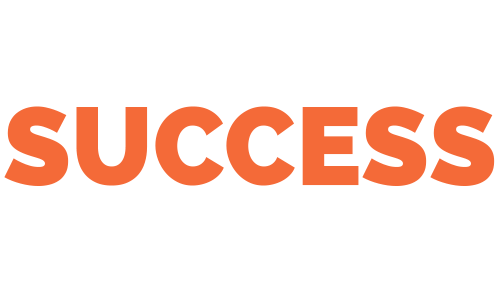

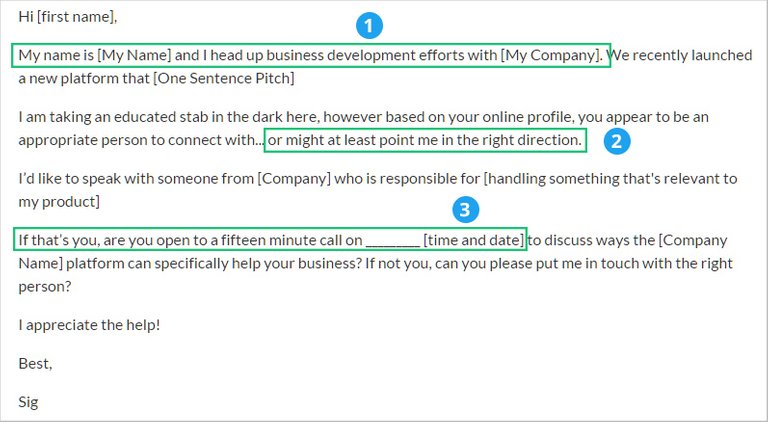
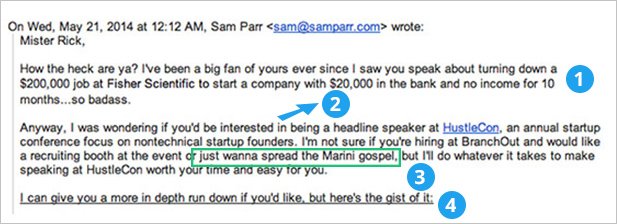
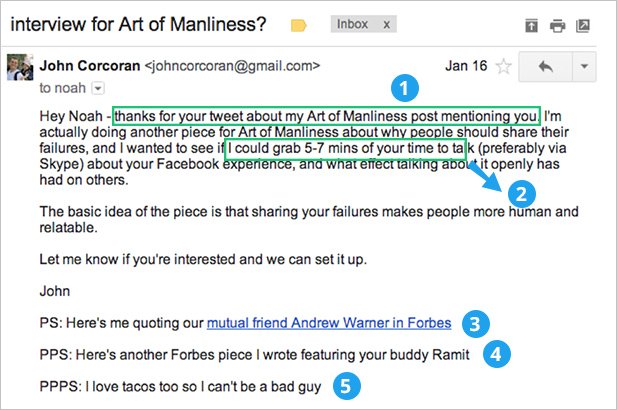
Ty for good article.
Epic mate.
As always, you provide actionable value in a succinct manner! Thank you!
http://dougcrowe.com
Yes the Follow Up is always important. @michaelx thanks for the 3 part training.
Many thanks! This will all be worth studying - I've felt a bit out of my depth helping do PR for Airkooled Kustoms, and this will help a lot.